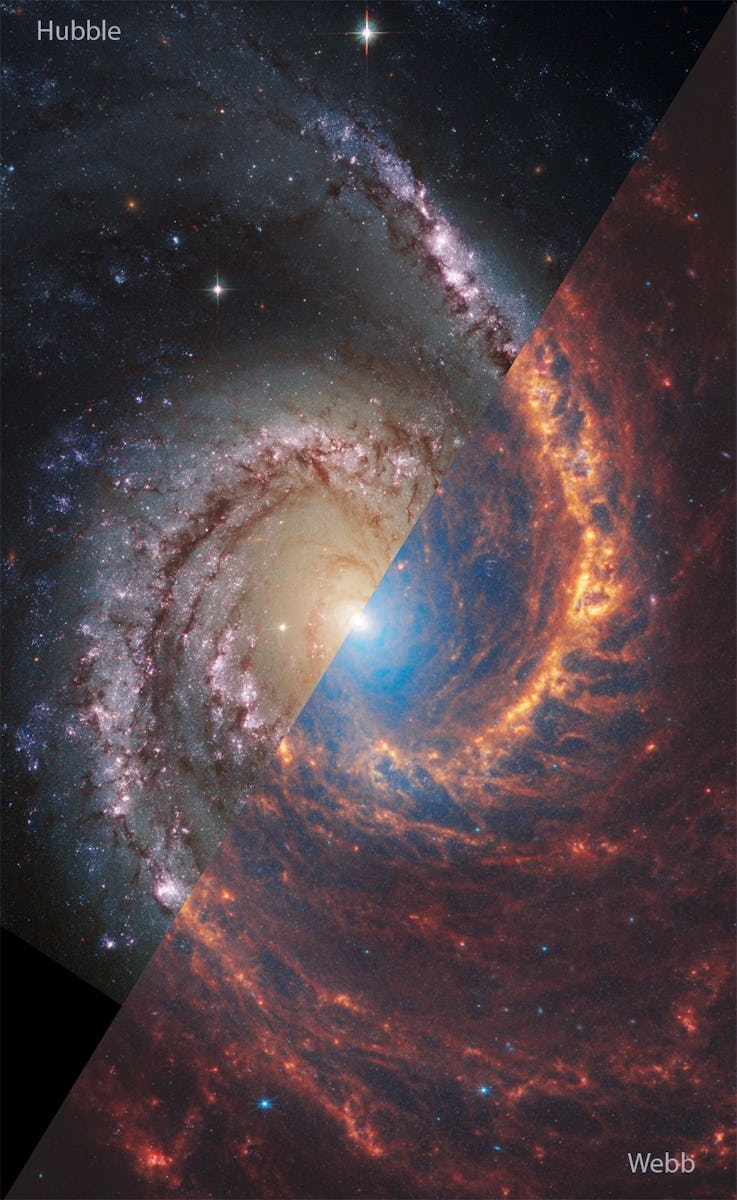You are alive, I said,
as I looked out the door.
My beloved stood before me, saying,
"I'm not. I'm not here anymore."
Public Posts Stanwood, WA Stanwood, WA (zoom)
NASA Astronomy Picture of the Day:
What's different about this galaxy? Very little, which makes the Spanish Dancer galaxy, NGC 1566, one of the most typical and photogenic spirals on the sky. There is something different about this galaxy image, though, because it is a diagonal combination of two images: one by the Hubble Space Telescope on the upper left, and the other by the James Webb Space Telescope on the lower right. The Hubble image was taken in ultraviolet light and highlights the locations of bright blue stars and dark dust along the galaxy's impressive spiral arms. In contrast, the Webb image was taken in infrared light and highlights where the same dust emits more light than it absorbed. In the rollover image, the other two sides of these images are revealed. Blinking between the two images shows which stars are particularly hot because they glow brighter in ultraviolet light, and the difference between seemingly empty space and infrared-glowing dust. Image Crunching Opportunity: Take NASA's Astrophoto Challenge
Photo by NASA, ESA, CSA, STScI, J. Lee (STScI), T. Williams (Oxford), R. Chandar (UToledo), D. Calzetti (UMass), PHANGS Team
Come and lay by my side,
if you want to.
Come and lay by my side,
if you care.
Come and lay by my side,
for I need you.
Come and lay by my side,
I'm in despair.
Come lay by my side,
if you can.
Come and lay by my side,
the side of a lonely old man.
My memories are clear.
and now do implore,
why don't I have my loved
one here when I need her more?
She was my rock and who,
I relied on to talk to me,
about anything. Now she's gone.
Here I sit. No one to console me.
I know I hear those who say,
"Get over it", she's gone,
and your lot will be to
remain as you are, alone!
From out the night, sprang forth,
a terrible person, an ugly event.
Why would you want to visit there,
when you had to live in a tent?
Tent living, is not so bad, someone,
decided, it was the best way.
He pitched his tent, a storm approached,
and blew this poor, unprepared man away.
When you live like a Nomad,
while traveling this World, broad,
you may encounter adversarial
people while you travel the road.
Women to the left of me,
women to the right.
I am in a state of
what's wrong or what's right.
NASA Astronomy Picture of the Day:
What's happening in the core of the Carina Nebula? Stars are forming, dying, and leaving an impressive tapestry of dark dusty filaments. The entire Carina Nebula, cataloged as NGC 3372, spans over 300 light years and lies about 8,500 light-years away in the constellation of Carina. The nebula is composed predominantly of hydrogen gas, which emits the pervasive red and orange glows seen mostly in the center of this highly detailed featured image. The blue glow around the edges is created primarily by a trace amount of glowing oxygen. Young and massive stars located in the nebula's center expel dust when they explode in supernovas. Eta Carinae, the most energetic star in the nebula's center, was one of the brightest stars in the sky in the 1830s, but then faded dramatically. Your Sky Surprise: What picture did APOD feature on your birthday? (post 1995)
Photo by Carlos Taylor
Hope springs eternal,
this, everyone knows.
Why do we cry when,
someone goes?
Must we hold on,
during this process of life,
when death is present,
creating personal strife?
I wish I knew,
I most certainly do,
when it involves someone
so familiar, like you.
What in the World,
has happened to you?
Your emotions, stretched thin,
like a map to Honshu.
A map of a Nation,
Honshu, a beautiful place.
A place of wellbeing,
among a Japanese race.
I remember Japan,
from my Navy days,
when I was a young man,
of 20 years and 265 days.
Words would come,
Words would go.
Now words are stalled,
No longer they flow.
Pushing the word,
into a writing flow,
if they exist,
I don't know.
How can you lose,
a word like "cool",
when you have become,
a real old fool?
A fool in the morning,
a fool in love.
I can be the same fool,
when viewed from above.
I want to be loved,
as I used to be.
I know my beloved,
would want that for me.
But here I sit,
like an idiotic dip,
wondering if I could
make such a trip.








.jpg?fit=crop&w=280&h=280&q=93)













 - Copy.jpg?fit=crop&w=280&h=280&q=93)


R.jpg?auto=format&fit=clip&w=600)





















